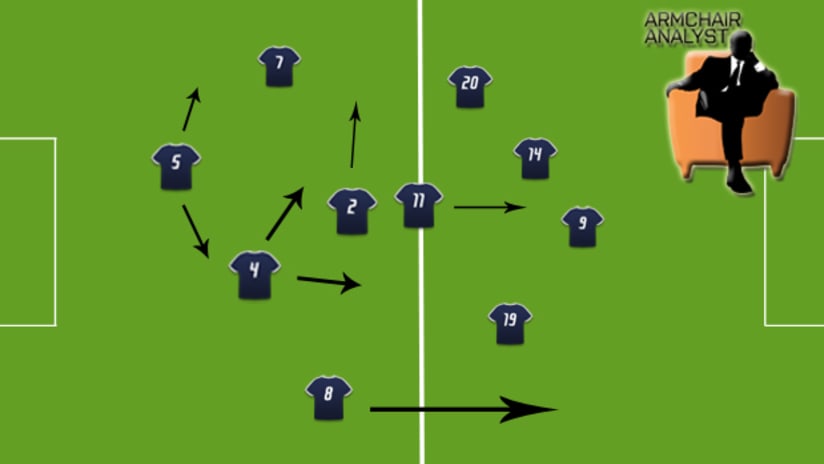Red Bulls coach Hans Backe came into 2011 with a plan. He wanted to play soccer “the right way.” Those are his words, and when Backe talks about “the right way” he means passing, possession, keeping the ball on the ground and using angles.
Every personnel move he made was part-and-parcel of the plan. And through five games, there was very little deviation: New York led the league in passes attempted and completed. They led in passing accuracy (83.13 percent) and were second in possession (58.44 percent). And last week against San Jose, everything came together in an emphatic 3-0 win.
But on Thursday night at RFK Stadium, Backe didn’t plan. He and his team improvised.
WATCH: Red Bulls romp over D.C. United, 4-0
United up for a fight
The big difference between Thursday’s 4-0 win over D.C. United and the other results RBNY have had in 2011 – including the win over the Quakes – is that DC took it to the Red Bulls. They attempted to play the same kind of passing, possession-based game that New York have put to such good use.
On several levels, it worked. New York conceded 58 percent possession and a staggering 558 passes to United, the latter a season-high in MLS. DC also completed over 83 percent of those passes to just 76.3 percent for the Red Bulls.
[inlinenode:334518]The way United did this – and the way teams will almost certainly go at Red Bull in the future – was by doing their best to cut NY defensive midfielder Teemu Tainio out of the game. Tainio has been the engine that drives RBNY, igniting the offense from deep and changing the point of attack with precision and regularity.
So DC coach Ben Olsen had either an advanced central midfielder (Dax McCarty in the first half, Branko Boskovic in the second) or one of the forwards shadow Tainio, forcing the Finnish d-mid to play the ball square or backwards instead of forward into New York’s dangerous attackers.
While specifically neutralizing Tainio was the right move, it was also suicidal to do so in a 4-4-2. Pushing either McCarty or Boskovic that high meant Clyde Simms was left to stop up the entire middle of the field all by his lonesome, the fatal flaw of the diamond-four midfield United ended up playing.
Marquez steps up
New York looked to the backline for their solution.
They countered United’s tactics by making central defender Rafa Márquez the central distribution hub, and from that perspective, Rafa played the best game of his brief MLS career. It’s not so much that his numbers were off the charts. Rather, Márquez simply seized every opportunity United offered, becoming the key to the counterattack and starting each of New York’s first three goals.
[inlinenode:334517]On the first he played directly to the feet of Dane Richards, who made a checking run deep into the midfield (at right). That drew left back Marc Burch out of position, and when McCarty didn’t come over to cover, Jan Gunnar Solli had the entire right half of the field to work with.
Solli’s cross ended up on the head of Thierry Henry, who scored his second header in as many games.
It’s worth noting that, while everything on the ball played out perfectly for Red Bull, the off-the-ball work (missing in action through the first four games of the season) was exemplary as well. Luke Rodgers and Henry actually set up their runs in midfield before Richards’ flick even reached Solli, giving the DC defenders a smaller window to decide which attacker to cover.
They chose poorly. Dejan Jakovic ended up following Rodgers to the near post, Simms had to cover Dwayne De Rosario’s late run, and Perry Kitchen slid out to try to stop Solli.
That left Henry with a wide open header to power past Bill Hamid.
The second Red Bull goal was an even better example of Márquez filling Tainio’s spot. With New York amid a long spell of possession and Tainio pulled all the way to the left touchline, Márquez stepped into the central midfield and hit a blind, 180-degree switch that, again, provided his team with the whole right side of the field to work with.
Several touches later, Henry was picking his second goal of the night out of the net.
DC don’t adjust
A lot of young managers and young teams would have pulled a man back into midfield at this point and gone with a 4-5-1 (or 4-2-3-1 depending on your wingers) to mitigate the damage. Honestly, at this stage of the season that’s the best way to beat New York, as Philadelphia and Peter Nowak showed a few weeks back in the second half of their 1-0 win.
But Olsen, like Backe, has a plan, and to his credit he stuck to it.
That meant subbing off Charlie Davies, who was running around like a rocketized offside machine all night, for another striker and going with two forwards for the duration, as well as playing the more offensive-minded Boskovic for McCarty. While that again gave United more of the ball, it also opened up space for the Red Bull counter, which – along with an incredible individual effort from Juan Agudelo – accounted for the final score line.
So be it. The lesson DC got about shape and patience will have more value down the road than the three points lost and four goals conceded.
For the Red Bulls, the lessons reinforced on the night were of the elementary variety: What you do without the ball is as important as what you do with it, and even the best-laid plans sometimes need some improvisation to become workable.
Matthew Doyle can be reached for comment at matdoyle76@gmail.com and followed on Twitter at @MLS_Analyst.





